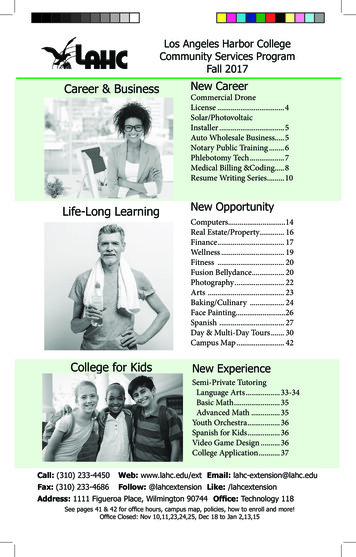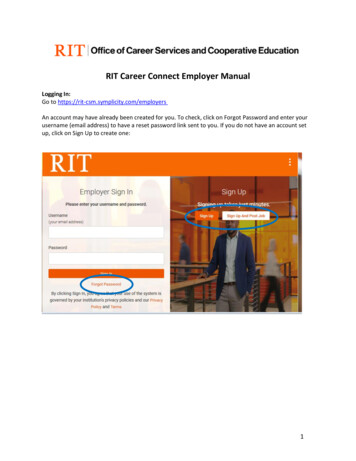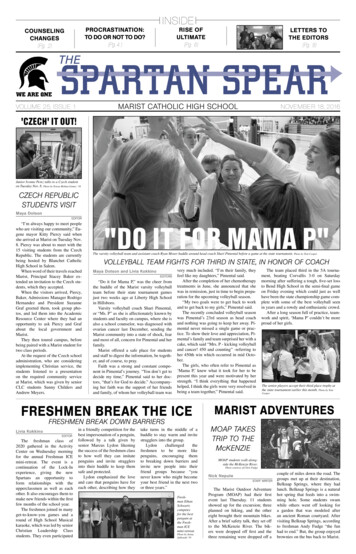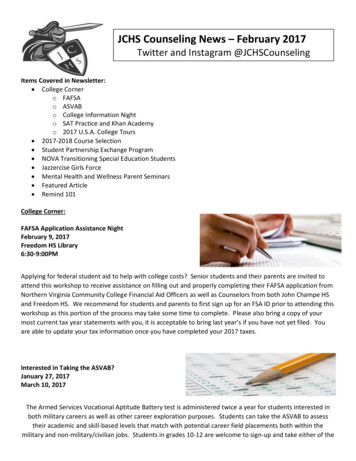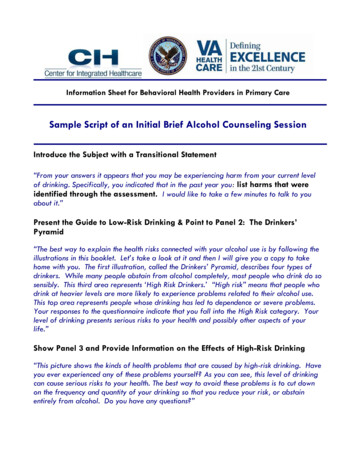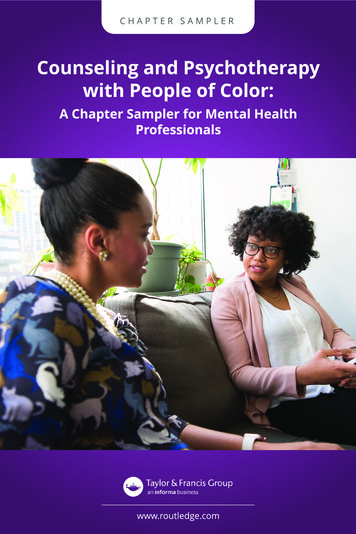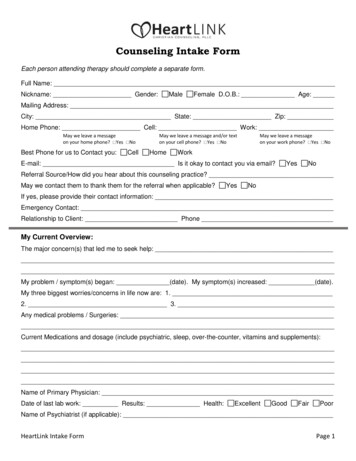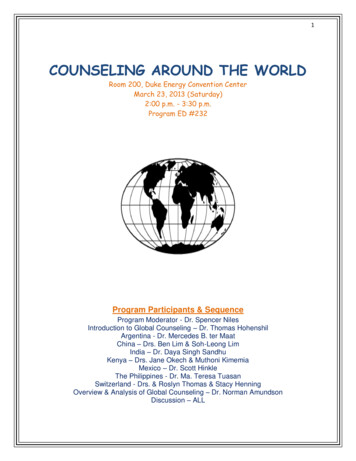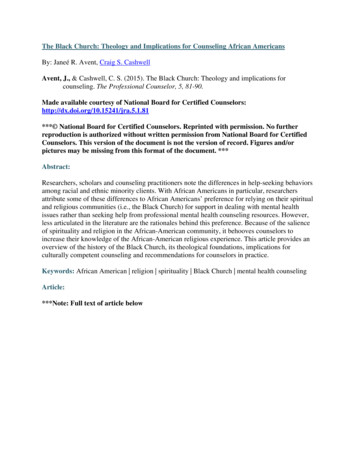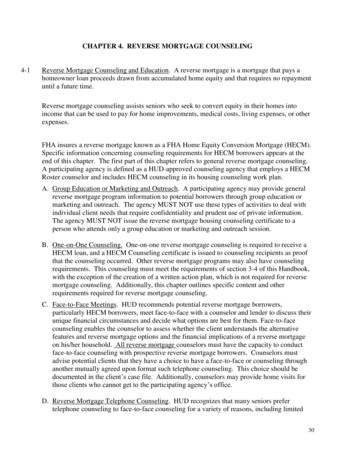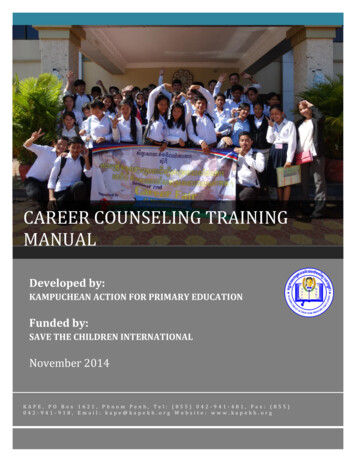
Transcription
CAREER COUNSELING TRAININGMANUALDeveloped by:KAMPUCHEAN ACTION FOR PRIMARY EDUCATIONFunded by:SAVE THE CHILDREN INTERNATIONALNovember 2014KAPE, PO Box 1621, Phnom Penh, Tel: (855) 042-941-481, Fax: (855)042-941-918, Email: kape@kapekh.org Website: www.kapekh.org
Table of Contents1.2.INTRODUCTION1.1 Overview1.2 Objectives and Purpose of This ManualEXPLANATION ABOUT HOW TO USE THIS MANUAL3.SESSION PLANS FOR THE TRAINERLesson 3.1: Purposes and Objectives of the Career Counseling ServiceLesson 3.2: General Operating StructureLesson 3.3: Service ContentLesson 3.4: Advertising Networking and OutreachLesson 3.5: Counseling TechniquesLesson3.6: Tracking, Database and Keeping Case Files4.HANDOUTS AND PARTICIPANT COURSE MATERIALSHandout 3.1.1.: Case Study Analysis - Problems with Career CounselingServices Provided in Schools under IBECHandout 3.1.2: Summary of Career Counseling Center ServicesHandout 3.1.3.: Matching Youth Needs to Counseling Center ServicesHandout 3.2.1: Summary of Operating Structure for Youth Counseling Center with Exercise SheetHandout 3.2.2: Office MapHandout 3.3.1: Job Descriptions for Career Counselor with breakdown byService AreaHandout 3.3.2: Summary Table of job description and specific tasksHandout 3.3.3:Participants list and Case FormHandout 3.4.1: EYE Youth NetworkingHandout 3.4.2: Service Map of Career Counseling Service Providers inKampong Cham Town and EnvironsHandout 3.4.3: Case studyHandout 3.4.4: Content of brochures – Exercise sheetHandout 3.5.1: Skills needed for counseling – Exercise sheetHandout 3.5.2: Ethical and unethical behaviorsHandout 3.5.3: Youth profile description for role-play2
1. INTRODUCTION1.1 OverviewGeneral: This manual is intended for CAREER COUNSELORS in lower secondary schoolsto provide support services to students that will prepare them both to find suitable employment and to stay employed. The planned support provided by counselors will helpstudents to prioritize what types of career they would like to have in the future. Thinking about careers at an early age helps students to acquire the necessary skills and experience they need in order to have a satisfying career and fulfill their potential, ratherthan just finding themselves in a job for which they have little motivation and littlechance of promotion.Target Groups: This manual has been developed for many different kinds of youth including those who are still in school as well as those who are about to leave or have already left (out-of-school youth). It is recommended, however, that counselors focus onstudents in the higher grades given that these are the students who are most likely toleave school and soon enter the workforce. However, the services provided can be of useand interest to all students in the school as well as youth who have already left school.We hope young people can become more forward thinking in their aspirations for theirfuture career and become more aware of the types of work, which would suit them.Additional Resource Books: This training is in addition to the World of Work life skillsmanual, which will further help students to understand and gain the soft skills requiredfor the workplace and how to apply for a job. The Career Advice Manual originally developed for school-based counselors also has useful activities about how to train a StudentCouncil about career planning. Career Counselors may also find this manual useful, especially with regards to capacity-building activities in schools. Finally, It should also benoted that the recently approved life skills manual entitled, Me and My Future also hasmuch information on future planning that could be useful with students in the lowergrades to prepare them for the more advanced career planning services discussed in thecurrent manual.1.2 Objectives and Purpose of This ManualPurpose of This Document: The present manual has been developed as a Training ofTrainers (ToT) document to assist in the preparation of recruited career counselors indelivering desired career counseling services as well as managing the counseling facilities established by KAPE for its target schools.Relevant Services: This content provided in this manual will help career counselors toassist students in accessing various services relating to career counseling. These services include: One-on-one counseling (especially for students and youth who are determined1
to be at particularly high risk).Access to brochures and written materialsUsing technology as a career-planning tool including access to tablets and desktop workstations in the Media Center of the Demonstration School as well as theYouth Counseling Center in the KAPE Main Office.Providing referrals to students about registration in workforce databases, postsecondary school study opportunities (both vocational and tertiary), selfemployment, getting loans from MFIs, and apprenticeships.Access to capacity-building workshops that will be organized from time to timeon career related topics such as: (i) understanding the difference between softand hard skills; (ii) finding a job; (iii) writing a CV and doing an interview; (iv)choosing a career path.Rationale for Training External Career Counselors: The establishment of externalCareer Counselors is intended to address a deficiency that occurred in many schoolswhere there were not enough school personnel to adequately carry out the tasks of acareer counselor. The identification and training of external Career Counselors who canfully focus on career planning activities directed at students and out-of-school youth isan intervention that KAPE has committed to establishing for youth in its target schoolsand which the agency will try very hard to continue to resource in the long-term. Thecurrent manual seeks to give a thorough orientation to recruited Career Counselorsabout how to effectively provide career-counseling support in collaboration with targetschools.2
2. EXPLANATION ABOUT HOW TO USE THISMANUALThis manual uses the following standard symbols used in the Life skills manuals, developed as part of the Improved Basic Education in Cambodia (IBEC) project.Timing Required for the Lesson Pre-Training Preparation: Contains information on how to set up your training area for learning activities. It also gives suggestions on how to organizematerials needed for the activity. Materials Needed: This provides an overview of necessary materials. Most ofthe time these will be very basic things, like pens or paper. Other material inthe training sessions will be provided through handouts that are attached inthis manual. Sometimes they need to be duplicated by the trainer.Learning Outcomes: Gives a statement of what should have been achievedand assessed at the end of the session.Steps and Process IconsSection 3 of this manual provides a series of training sessions on how to train the recruited Career Counselors. The symbols below are used to help guide the actual trainingsession. These symbols will tell the facilitator quickly what sorts of activities need to beplanned for in this part of the training session. This section of the manual includes possible activities, stimulating questions, examples to clarify exercises and optional extratasks. Although it is advisable to read through the whole lesson clearly from the beginning, especially when it’s used for the first time, the trainer can easily see what he or shehas to do because of the icons used. Action to be Taken: This symbol indicates that the facilitator must take a concrete action such as passing out a Handout, re-arranging desks, organizegroups, etc. Questioning Behavior: This indicates that the facilitator needs to ask a keyquestion to the participants as a prelude to an activity or discussion. Discussion: This symbol indicates that the facilitator must lead a discussion orallow participants to discuss something in their groups. Writing Tasks: This symbol indicates that the participants need to writesomething on poster paper, complete an exercise, or other written task.Explanation: This symbol indicates the facilitator must explain something toparticipants.3
3. CAREER COUNSELING SESSION PLANSCourse Outline and Materials4
Lesson 3.1- Purpose and Objectives of the Career CounselingService Lesson Time: 90 MinutesTrainer Preparation: Write up the Learning Outcomes of the lesson on a sheet of poster paper to introduce the lesson. Make copies of Handout 3.1.1: Case Study Analysis - Problems withCareer Counseling Services Provided in Schools under IBEC Make copies of Handout 3.1.2: Summary of Career Counseling CenterServices Make copies of Handout 3.1.3: Matching exercise (Needs & Services)Resources/Materials: Poster paper, marker pens Poster sheet summarizing the learning outcomes of the lesson. Handout 3.1.1: Case Study Analysis - Problems with Career CounselingServices Provided in Schools under IBEC Handout 3.1.2: Summary of Career Counseling Center Services Handout 3.1.3: Matching exercise (Needs and Services)Learning Outcomes: Participants can explain why the current counseling structure servicehas been created based on a case study and discussion. Participants can indicate the services that the Career Counseling Service will provide. Participants can briefly summarize the content of each of the CareerCounseling Services discussed during the lesson. Participants can match specific youth needs with services that thecounseling center will provide.5
Training StepsOutcomes of the LessonPlace a sheet of poster paper up on the board that summarizes the learningoutcomes for the lesson. Explain the outcomes and that this is what the participants should be able to do at the completion of the lesson.Why Schools Need A Career Counseling Service Pass out the Case Study Analysis to participants (Handout 3.1.1) and explainthat this document gives an analysis of why counseling services in the pasthave not been so effective. Ask participants to read the case study. Give them about 10 minutes for themto do so. When participants have finished reading the case study analysis, lead a discussion with participants that identifies what the problems that the current Career Counseling Service seeks to address and how it will do so. Make a copy of the table in Handout 3.1.1 on the whiteboard and complete thetable as your discussion progresses. Some examples have been provided below to help you properly guide the discussion and the completion of the table.Perceived Problem The Manner in Which EYE Counseling Service Will Address the ProblemsNo school personnel to provide adequate career counseling support toyouthSchool managers are too busy tospend any time on counseling so activities were not done well.Many at-risk youth were not identified Use of external counselors but linked with theschool External counselors can focus exclusively oncareer counseling services No individualized counseling for anystudents or youth No information on micro-financeloansNo information on where to studyfurtherNo services for out-of-school youth Focus on Grade 8 students only Counselors will have a computerized database to identify and track youth who are mostat riskA special office with privacy will be set inplace to meet with individual youth as needed.Outreach to MFIs to meet with students andyouth at schoolOutreach to Vocational Training institutionsto meet with students and youthOutreach to out-of-school youth thru database and tracking servicesFocus on all students, especially Grade 9 6
Services that Will Be Provided by the Career Counseling Center Pass out Handout 3.1.2 to all participants. Give a short explanation about thedescribed services, allowing participants to ask for clarifications as you go.Make sure that participants understand that services provided at the YouthCenter are interdependent and not isolated to the other services.Using Services Provided by the Career Counseling Service to Meet YouthNeedsFollowing the explanation about the services that the center will provide inHandout 3.1.2, explain to participants that they are going to try to apply whatthey just learned to see if they can match services with youth needs that theyencounter. There may be some needs that cannot be met by the center, whichshould be referred to another more experienced service provider (e.g., domestic abuse, etc.). Next, pass out Handout 3.1.3 with a Needs-to-Service matching exercise. Read the directions to the participants and have them begin discussing thetask together. This exercise may be done individually, as a large group, or insmall groups. After participants have completed their worksheets, discuss as a large groupto determine that there is a good consensus about matching needs to availableservices.At the end of the lesson, show again the learning outcomes of this lesson andcheck with participants their knowledge acquired.7
Lesson 3.2: General Operating Structure Lesson Time: 60 MinutesTrainer Preparation: Write up the Learning Outcomes of the lesson on a sheet of poster paper to introduce the lesson. Make copies of Handout 3.2.1: Summary of Operating Structure forYouth Counseling Center with Exercise Sheet Draw a Map of the Youth Counseling Center on the whiteboard and paper strips marking different functional areas as indicated in the SessionPlan.Resources/Materials: Poster paper, marker pens Poster sheet summarizing the learning outcomes of the lesson. Handout 3.2.1: Summary of Operating Structure for Youth CounselingCenter with Exercise Sheet Office MapLearning Outcomes: Participants can state basic operating guidelines about the career counseling service including hours of operation, the function of different location offices (e.g., KAPE Office and Demonstration School), targetgroups, the division of labor among staff, and the relationship with surrounding schools and institutions. Participants can identify the functions of different locations organizedin each office location using an office map.8
Training StepsOutcomes of the LessonPlace a sheet of poster paper up on the board that summarizes the learningoutcomes for the lesson. Explain the outcomes and that this is what the participants should be able to do at the completion of the lesson.Setting up of basic operating guidelinesTell the participants to brainstorm about operating guidelines of Youth Centerand Media Center individually. Participants have to reflect about hours of operation, the function of Youth Center and Media Centre, target groups, the division of labor among staff, and the relationship with surrounding schools andinstitutions. Give participants 5 to 7 minutes to write down their ideas on the table(Handout 3.2.1.)Each participant has to share their ideas. Facilitator writes ideas on the whiteboard. Then participants sort out all ideas to make a definitive operatingstructure for Youth center.A table with Basic operating structureBasic OperatingGuidelinesHours of operationFunction of different location officesDetails 8am – 12pm pm – 5pm Monday to FridayKAPE Office – Youth Center: One-on-one counseling ( walk-in or withappointment) Referrals & follow-up Tracking & Case files Capacity building workshops & presentationsDemonstration School-Media Center: Self-study about career options with IMacs& Tablets, Smart phone. Get information from bulletin board, brochures, and research by Internet 9
Target groups Division of labor amongstaff Relationship with surrounding schools & institutionsBoth Youth Center & Media Center areavailable for different kinds of targetgroups. Students in school and youth whoare about to leave school or have alreadyleft (out-of-school youth). Counselors willfocus on students in the higher grades inorder to help them to think about the future(job and study opportunities). Those aremost likely to leave school and soon enterthe workforce.1 counselor stays in the Youth Center fromMonday to Friday.1 counselor stays in the Media Center fromMonday to Friday to help youths to searching, finding information online. The counselor is the Media Center will take care of updating data from attending list and CaseForm.Counselors might visit schools to give youthinformation about the Youth Center. Theyalso visit schools to update informationabout high risk students. Counselors oftenneed to contact institutions to update information about companies, MFIs, universities and vocational training centers by getting new brochures and application forms.Identify locations on office maps By looking at the whiteboard, participants have to identify together whichplace is the most appropriate place for each service provided at the Youth Center. They have about 10 minutes to discuss. Once they all agree on the locations, participants come to the whiteboard and by using paper strips, theyshare their ideas by showing the area and explaining their choices. The following areas must be identified: one-on-one counseling, referrals, self-study,workshop and presentation.Explain to participants by showing Youth Center office map and then givingexplanation for each location to participants (Office map in Handout 3.2.2)At the end of the lesson, show again the learning outcomes of this lesson andcheck with participants their knowledge acquired.10
Lesson 3.3: Service Content Lesson Time: 90 MinutesTrainer Preparation: Write up the Learning Outcomes of the lesson on a sheet of poster paper to introduce the lesson. Make copies of Handout 3.3.1: Job Descriptions for Career Counselorwith breakdown by Service Area Make copies of Handout 3.3.2: Summary Table Job description andTask Make copies of Handout 3.3.3: Participants List and Case formResources/Materials: Handout 3.3.1: Job Descriptions for Career Counselor with breakdownby Service Area Handout 3.3.2: Summary Table Job description and Task Handout 3.3.3: Participants List and Case formLearning Outcomes: Participants can briefly explain the content of each of the services thatwill be provided by the Career Counseling Center. Participants can describe key tasks that they must perform for each ofthe services being provided by the Career Counseling Center. Participants can demonstrate how youth should complete case formsthrough selected exercises and/or role plays. They can also indicatewhy they are important, and how they can be used to help the Centeroperate efficiently.11
Training StepsOutcomes of the LessonPlace a sheet of poster paper up on the board that summarizes the learningoutcomes for the lesson. Explain the outcomes and that this is what the participants should be able to do at the completion of the lesson.Job description of each of the services provided Pass out Handout 3.3.1 to all participants. Give a short explanation on the jobdescription for each service and allow participants to ask for clarifications asyou go.Key Tasks related to each of the services provided Based on Handout 3.3.1, ask participants to think about specific key tasks foreach of the services that will be provided by the Youth Center. Participantsbrainstorm individually or in small groups. They write down their ideas in thelast column of the table in Handout 3.3.1.When participants have finished, lead a discussion about the specific tasksparticipants have identified. Write all ideas on the whiteboard as the discussion progresses. Complete participants; ideas if some tasks have been forgotten.Pass out handout 3.3.2. This table summarizes job descriptions and key tasksthat counselors must perform for each of the services being provided by theCareer Counseling Center. Compare the key tasks identified with the earlierdiscussion that occurred to complete Handout 3.3.1.Role-play: Help youth to complete Participant Lists and Case Forms Pass out Handout 3.3.3 to all participants. Give a short explanation on how tocomplete the participants list and Case Form. Make sure that all participantsunderstand each section and question on the Case Form. Ask participants toexplain some sections to make sure they know how to deal perfectly with CaseForm. Let participants ask questions if needed. Once the use of both forms isclear, ask participants to practice with a role-play. Examples of specific situations are available at the end of Handout 3.3.3.12
Note: It is important for the participants list to be consistently completed andsigned by each youth every time they come to the Center (even if youth just wantto have a look at books or search information on computer). The Case Form mustbe completed by participants who get one-on-one counseling, referrals or whoattend group capacity-building workshops/presentations in addition to the participants list. Once a youth has filled in his/her Case Form, it is important to update the same form (see lesson 6 for more details).At the end of the lesson, show again the learning outcomes of this lesson andcheck with participants their knowledge acquired.13
Lesson 3.4: Advertising, Networking, and Outreach Lesson Time: 90 MinutesTrainer Preparation: Write up the Learning Outcomes of the lesson on a sheet of poster paper to introduce the lesson. Make copies of Handout 3.4.1: EYE youth networking Make copies of Handout 3.4.2: Job Service Map of Career Counselingservice providers in Kampong Cham Make copies of Handout 3.4.3: Case studyResources/Materials: Handout 3.4.1: EYE youth networking Handout 3.4.2: Job Service Map of Career Counseling service providersin Kampong Cham Handout 3.4.3: Case studyLearning Outcomes: Participants can use EYE network to advertise information about theCareer Counseling Center as discussed during the lesson. Participants can use the Service Map of Career Counseling Service providers to advice and refer youth to the appropriate service providersaccording to his/her needs. Participants can explain the content of brochures and other written materials from service providers such as NEA documents, Career AdviceManual, World of Work and Me and My Future and what contexts thesewould be relevant in.14
Training StepsOutcomes of the LessonPlace a sheet of poster paper up on the board that summarizes the learningoutcomes for the lesson. Explain the outcomes and that this is what the participants should be able to do at the completion of the lesson.Advertising in Cambodia Ask participants to describe the types of advertisements normally used inCambodia. All ideas should be displayed on the whiteboard. When participantsdon’t have any ideas left, give more details about advertisements (its role andpurpose) and add to participants’ ideas if needed. Make a diagram similar tothat shown below to record the ossible Answer: By brochures and flyers, newsletter, bulletin board, posterpaper, magazines, newspapers and other written material, Radio, TV, Network,Facebook, Internet, mobile phone, video The purpose of advertising is to convince customers that a company's services or products are the best, enhance the image of the company, point outand create a need for products or services, announce new products and programs and to hold existing customers.15
How to announce information about services provided in the Youth Center? Participants think individually or discuss in pair during 10min. Lead a discussion to share participants ‘ideas. Show and explain to participants, the EYE network (Handout 3.4.1.). Participants should be able to use this network to advertise the Youth Center ‘services. Other ways of advertisement can be used such as brochure, posters, flyer and sign. A newsletter can be created and spread to EYE network. The bulletin board will be used as an important source of information for youths andstudents as the monthly schedule of workshop will be displayed. Radio couldalso be used as many people listen to the radio, it might enable to reach out-ofschool youths easily. EYE traditional way of advertisement will also be usedsuch as Facebook, MASS SMS and phone calls. Counselor could also visit schoolto make more students know about the new Career Counseling Center.What Services Providers do you know in Kampong Cham? And what kindof services do they provide to youth? Discuss the question above together and list the services providers participants know. If some services providers seem very interesting and not in EYEnetworking, write down the name of the service providers. This can be a goodway to extend EYE networking as well. This should last only a few minutes.After the short introduction discussion, distribute the Service Map of CareerCounseling service providers in Kampong Cham (Handout 3.4.2.). Read thedocument together and let participants to ask questions as you go on.Once the content of Service providers is clear for participants, pass out theCase Study in Handout 3.4.3. In small groups, ask participants to decide whichservice provider counselor should send youth (from case study) to. Then discuss in a big group, each group should explain its decision to youths to thespecific service provider.Content of brochures and other written materials from service providersfrom network Pass out the Handout 3.4.4 and give participants as many brochures and fliersas you can. Ask participants to fill in the table. Participants need to find thebrochure matching the content description. Once they have matched the content to the right brochure, participants need to describe in what context thesebrochures would be relevant in.The table below gives an example to help you lead a discussion with participants after the exercise is done individually or in small groups.16
Brochure’s contentLabor Bulletin of NEAoooooooNew information about careerShort course skillsTrainings or workshopsGuide book of career counselingWorkplace skillJob announcementLabor market informationNote: It’s updated every two monthsLeaflet of NEAoAnnouncement about their serviceso Website, Facebook, Email, Phonenumber, their locations, thedates and the time their announce on TVJob Dictionary from SiparooooIf youths want to get short courseskillo If youths want to join a trainingor workshopo To advice youth how to set a goalfor future or work plan for futurejobo To give advice to youth aboutjobs they could choose for theirfuture career according to theirinterest and skillso Disseminate information to youthon how to find jobs or internshipso Help youth out of school to findjobso Easy to send youths to get services neededo Help youth to search from NEAleaflet information to find jobs,know about scholarship opportunities, job announcements byTV, employment opportunities oCounselor helps youths to findspecific job according to theirjob field interest. For example:in the health section of the book, youth can find jobs such asnurse, doctor, dentist, pharmacist and know more about eachof those jobs.oTo prepare Capacity BuildingworkshopsRelevant topics such as Motivation, Work plan, Good behaviorsat school and at work, good teamworks, how to write CV and howto prepare an interviewjob category with specific jobsWorld of WorkooooooooRelevant context to use the brochureIntroducing Soft-SkillsA new type of workplaceMotivation for workingA highly motivated workerPreparing for tomorrow’s workEffective behavior at workA good team memberHow to handle conflict in theworkplaceHow to write CV’s and cover lettersA successful job interviewo17
Me & My FutureoooooooGoals settingGoals and your futureOccupation Interests and InvestigationInterviewsPlanning for your futureDecision MakingThe Wise Decision MakingoooFor One-on-One counseling andCapacity building workshopsHelp youths to set up goals for thirfuture, and plan their future.Use Occupation mapping and makedecision make to help youths.At the end of the lesson, show again the learning outcomes of this lesson andcheck with participants their knowledge acquired.18
Lesson 3.5: Counseling Techniques Lesson Time: 120 MinutesTrainer Preparation: Write up the Learning Outcomes of the lesson on a sheet of poster paper to introduce the lesson. Make copies of Handout 3.5.1: Skills Needed for Counseling - ExerciseSheet. Make copies of Handout 3.5.2: Ethical and Unethical Behavior Make copies of Handout 3.5.3: Youth profile description for role-playResources/Materials: Poster paper, marker pens Poster sheet summarizing the learning outcomes of the lesson. Handout 3.5.1: Skills needed for Counseling - Exercise Sheet. Handout 3.5.2: Ethical and Unethical Behavior Handout 3.5.3: Youth profile description for role-play.Learning Outcomes: Participants can identify youth’s problem and offer one-on-one counseling to help youth to find a good job or to achieve their future dreams. Participants can describe and apply various counseling techniques suchas skills and counseling behaviors that they have learned in the lesson. Participants can demonstrate through role play how they might faceany emotional situation to help youth to overcome an obstacle and goforward as practiced during the lesson.19
Training StepsOutcomes of the LessonPlace a sheet of poster paper up on the board that summarizes the learningoutcomes for the lesson. Explain the outcomes and that this is what the participants should be able to do at the completion of the lesson.Skills needed for counseling with youthExplain participants the importance of techniques and skills in counseling. Infact, effective counseling is highly dependent on the skills and techniques ofthe counselor. Though counselors can learn by reading, writing and talkingabout counseling, if they are to become competent counselors, they have tolearn by practicing and doing it. Pass out the Handout 3.5.1 about Skills needed for counsellors. When participants have finished filling in the table, lead a discussion with participants about what skills they identified and the importance of those skills tobecome a good counselor. Ask participants to complete the table individually or in small groups during15- 20min. Facilitat
MANUAL This manual uses the following standard symbols used in the Life skills manuals, devel-oped as part of the Improved Basic Education in Cambodia (IBEC) project. Pre Timing Required for the Lesson -Training Preparation: Contains information on h
